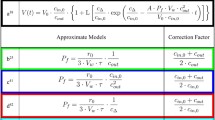Summary
Unidirectional and net water movements were determined, in frog urinary bladders, before and after glutraldehyde fixation. Experiments were performed in three experimental conditions: 1) in nonstimulated preparations, 2) after the action of antidiuretic hormone (ADH) and 3) in nonstimulated preparations to which amphotericin B was incorporated from the luminal bath. As previously observed for net water fluxes, the increase in the unidirectional water movement induced by ADH was well preserved by glutaraldehyde fixation. After correction for the effects of unstirred layers and nonosmotic pathways, the observed correlation between the ADH-induced increases in the osmotic (Pf) and diffusional (Pd) permeability coefficients was not modified by the fixative action (before glutaraldehyde: slope 11.19,r:0.87±0.07;n=12; after glutaraldehyde: slope 10.67,r:0.86±0.04,n=39). In the case of amphotericin B, ΔPf/ΔPd=3.08 (r: 0.83±0.08), a value similar to that observed in lipid bilayers or in nonfixed toad urinary bladders. It is concluded that 1) The experimental approach previously employed to study water channels in artificial lipid membranes and in amphibian urinary bladders, can be applied to the glutaraldehyde-fixed frog urinary bladder. 2) Glutaraldehyde fixation does not modify the permeability properties of the ADH-induced water channels. 3) Any contribution of exo-endocytic processes or cell regulatory mechanisms to the observed permeability parameters can probably be excluded. 4) Glutaraldehyde-fixed preparations are a good model to characterize these water pathways.
Similar content being viewed by others
References
Bourguet, J., Jard, S. 1984. Un dispositif automatique de mesure et d'enregistrement du flux net d'eau à travers la peau et la vessie des amphibiens.Biochim. Biophys. Acta 88:442–444
Carasso, N., Favard, D., Bourguet, J., Jard, S. 1966. Rôle du flux net d'eau dans les modifications ultrastructurales de la vessie de grenouille stimulée par l'ocytocine.J. Microscopie 5:519–522
Chevalier, J., Bourguet, J., Hugon, J.S. 1974. Membrane associated particles. Distribution in frog urinary bladder epithelium at rest and after oxytocin treatment.Cell Tissue Res. 152:129–140
Eggena, P. 1972. Glutaraldehyde-fixation method for determining the permeability to water of the toad urinary bladder.Endocrinology 91:240–246
Eggena, P. 1972. Temperature dependence of vasopressin action on the toad bladder.J. Gen. Physiol. 59:519–533
Eggena, P. 1972. Osmotic regulation of toad bladder responsiveness to neurohypophyseal hormones.J. Gen. Physiol. 60:665–678
Eggena, P. 1983. Effect of glutaraldehyde on hydrosmotic response of toad bladder to vasopressin.Am. J. Physiol. 244:C37-C43
Ellis, S.J., Kachadorian, W.A., Discala, V.A. 1980. Effect of osmotic gradient on ADH-induced intramembranous particle aggregates in toad bladder.J. Membrane Biol. 52:181–184
Finkelstein, A., Holz, R. 1973. Aqueous pores created in thin lipid membranes by the polyene antibiotics nystatin and amphotericin B.In: Membranes a Series of Advances. G. Eisenman, editor. Vol. 2. pp. 377–408. M. Dekker. New York
Ginzburg, B.Z., Katchalsky, A. 1963. The frictional coefficients of the flow of non-electrolytes througth artificial membranes.J. Gen. Physiol. 47:403–418
Hardy, M., Dibona, D. 1982. Microfilaments and the hydrosmotic action of vasopressin in toad urinary bladder.Am. J. Physiol. 243:C200-C204
Hays, R.M., Franki, N. 1970. The role of water diffusion in the action of vasopressin.J. Membrane Biol. 2:263–276
Hebert, S.C., Schafer, J.A., Andreoli, T.E. 1981. The effect of antidiuretic hormone (ADH) on solute and water transport in the mammalian nephron.J. Membrane Biol. 58:1–19
Jard, S., Bourguet, J., Carasso, N., Favard, P. 1966. Action de divers fixateurs sur la perméabilité et l'ultrastructure de la vessie de grenouille.J. Microscopie 5:31–50
Kachadorian, W.A., Muller, J., Rudich, S.W., Discala, V.A. 1979. Temperature dependance of ADH-induced water flow and intramembranous particle aggregates in toad bladder.Science 205:910–913
Kachadorian, W.A., Wade, J.B., Discala, V.A. 1975. Vasopressin-induced structural change in toad bladder luminal membrane.Science 190:67–69
Levine, S.D., Jacoby, M., Finkelstein, A. 1984. The water permeability of toad urinary bladder: I. Permeability of barriers in series with the luminal membrane.J. Gen. Physiol. 83:529–541
Levine, S.D., Jacoby, M., Finkelstein, A. 1984. The water permeability of toad urinary bladder: The value ofPf/Pd (w) for the antidiuretic hormone-induced water permeation pathway.J. Gen. Physiol. 83:543–561
Levine, S.D., Kachadorian, W.A. 1981. Barriers to water flow in vasopressin-treated toad urinary bladder.J. Membrane Biol. 61:135–139
Moura, T.F., Macey, R.I., Chien, D.Y., Karan, D., Santos, H. 1984. Thermodynamics of all-or-non water channel closure in red cells.J. Membrane Biol. 81:105–111
Muller, J., Kachadorian, W.A., Discala, V.A. 1980. Evidence that ADH stimulated intramembranous particle aggregates are transferred from cytoplasmic to luminal membranes in the toad bladder epithelial cells.J. Cell Biol. 85:83–95
Parisi, M., Bourguet, J. 1983. The single-file hypothesis and the water channels induced by antidiuretic hormone.J. Membrane Biol. 71:189–193
Parisi, M., Bourguet, J. 1984. Effects of cellular acidification on ADH-induced intramembranous particle aggregates.Am. J. Physiol. 246:C157-C159
Parisi, M., Bourguet, J., Ripoche, P., Chevalier, J. 1979. Simultaneous minute by minute determination of unidirectional and net water fluxes in frog urinary bladder: A reexamination of the two barriers in series hypothesis.Biochim. Biophys. Acta 556:509–523
Parisi, M., Montoreano, R., Chevalier, J., Bourguet, J. 1981. Cellular pH and water permeability control in frog urinary bladder: A possible action on the water pathway.Biochim. Biophys. Acta 648:267–274
Parisi, M., Ripoche, P., Prevost, G., Bourguet, J. 1981. Regulation by ADH and cellular osmolarity of water permeability in frog urinary bladder: A time course study.Proc. N. Y. Acad. Sci. 372:144–162
Parker, J.C. 1984. Glutaraldehyde fixation of sodium transport in dog red blood cells.J. Gen. Physiol. 84:789–803
Pietras, R.J., Wright, E.M. 1975. The membrane action of antidiuretic hormone (ADH) on toad urinary bladder.J. Membrane Biol. 22:107–123
Rosenberg, P.A., Finkelstein, A. 1960. Interaction of ions and water in gramicidin A channels. Streaming potentials across lipid bilayer membranes.J. Gen. Physiol. 72:327–340
Rosenberg, P.A., Finkelstein, A. 1980. Water permeability of gramicidin-A treated lipid bilayer membranes.J. Gen. Physiol. 72:341–350
Author information
Authors and Affiliations
Rights and permissions
About this article
Cite this article
Parisi, M., Merot, J. & Bourguet, J. Glutaraldehyde fixation preserves the permeability properties of the ADH-induced water channels. J. Membrain Biol. 86, 239–245 (1985). https://doi.org/10.1007/BF01870603
Received:
Revised:
Issue Date:
DOI: https://doi.org/10.1007/BF01870603




